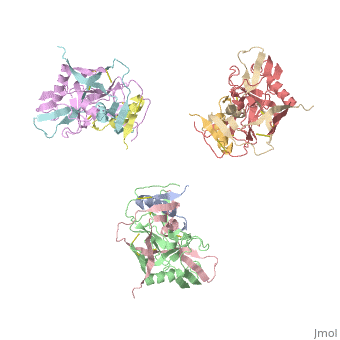Hiv env proteins
From Proteopedia
(Difference between revisions)
| Line 12: | Line 12: | ||
== gp120 Binding == | == gp120 Binding == | ||
| - | gp120 is responsible for the binding of HIV to CD4 cells. "Binding of gp120 to the primary receptor CD4 and coreceptor (for example, CCR5 and CXCR4) induces large conformational changes, which then trigger dissociation of gp120 and a cascade of refolding events in gp41" <ref name=Guan>PMID: 21076402 </ref>. In the unliganded state, the <scene name='Sandbox/Gp120_v1_v2_loops/1'>V1/V2 loops</scene> are located at the center of the apex of the trimer and hold the trimer together. However, when <scene name='Sandbox/Gp120_v1_v2_loops/2'>CD4</scene> binds to gp120, the V1/V2 loops undergo an outward rotational change that expose the central gp41 proteins at the base of the Env protein. gp120 is often complexed with <scene name='Hiv_env_proteins/Cd4_gp120_complex/1'>CD4</scene> and an antibody Fab (17b-Fab). "The 17b antibody has been shown to stabilize and lock gp120 in the CD4-bound conformation" <ref name=Nick>PMID: 18668044 </ref>. "Residues in contact are concentrated in the span from 25 to 64 of CD4, but they are distributed over six segments of gp120" <ref name=Nich>PMID: 9641677 </ref>. However, the most important gp120/CD4 <scene name='Hiv_env_proteins/Cd4_gp120_complex/2'>interactions</scene> are between "Phe 43 and Arg 59 of CD4 [which] make multiple contacts centered on residues Asp 368, Glu 370 and Trp427 of gp120, which are all conserved among primate immunodeficiency viruses" <ref name=Nich>PMID: 9641677 </ref> | + | gp120 is responsible for the binding of HIV to CD4 cells. "Binding of gp120 to the primary receptor CD4 and coreceptor (for example, CCR5 and CXCR4) induces large conformational changes, which then trigger dissociation of gp120 and a cascade of refolding events in gp41" <ref name=Guan>PMID: 21076402 </ref>. In the unliganded state, the <scene name='Sandbox/Gp120_v1_v2_loops/1'>V1/V2 loops</scene> are located at the center of the apex of the trimer and hold the trimer together. However, when <scene name='Sandbox/Gp120_v1_v2_loops/2'>CD4</scene> binds to gp120, the V1/V2 loops undergo an outward rotational change that expose the central gp41 proteins at the base of the Env protein. gp120 is often complexed with <scene name='Hiv_env_proteins/Cd4_gp120_complex/1'>CD4</scene> and an antibody Fab (17b-Fab). "The 17b antibody has been shown to stabilize and lock gp120 in the CD4-bound conformation" <ref name=Nick>PMID: 18668044 </ref>. "Residues in contact are concentrated in the span from 25 to 64 of CD4, but they are distributed over six segments of gp120" <ref name=Nich>PMID: 9641677 </ref>. However, the most important gp120/CD4 <scene name='Hiv_env_proteins/Cd4_gp120_complex/2'>interactions</scene> are between "Phe 43 and Arg 59 of CD4 [which] make multiple contacts centered on residues Asp 368, Glu 370 and Trp427 of gp120, which are all conserved among primate immunodeficiency viruses" <ref name=Nich>PMID: 9641677 </ref>. [[Image:3D structure of the HIV-1 spike in complex with CD4 and 17b- Fab.png|thumb|left|<ref name=Nick>PMID: 18668044 </ref>]] |
| - | + | ||
Revision as of 08:16, 27 November 2012
| |||||||||||
References
- ↑ 1.0 1.1 1.2 1.3 Frey G, Chen J, Rits-Volloch S, Freeman MM, Zolla-Pazner S, Chen B. Distinct conformational states of HIV-1 gp41 are recognized by neutralizing and non-neutralizing antibodies. Nat Struct Mol Biol. 2010 Dec;17(12):1486-91. Epub 2010 Nov 14. PMID:21076402 doi:10.1038/nsmb.1950
- ↑ 2.0 2.1 2.2 2.3 2.4 Liu J, Bartesaghi A, Borgnia MJ, Sapiro G, Subramaniam S. Molecular architecture of native HIV-1 gp120 trimers. Nature. 2008 Sep 4;455(7209):109-13. Epub 2008 Jul 30. PMID:18668044 doi:10.1038/nature07159
- ↑ 3.0 3.1 Kwong PD, Wyatt R, Robinson J, Sweet RW, Sodroski J, Hendrickson WA. Structure of an HIV gp120 envelope glycoprotein in complex with the CD4 receptor and a neutralizing human antibody. Nature. 1998 Jun 18;393(6686):648-59. PMID:9641677 doi:10.1038/31405



